Spices
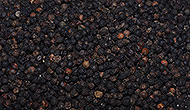
Scientific name : Piper nigrum
Black Pepper is the dried mature berry of Piper nigrum, a climbing, perennial shrub mostly found in hot, moist region of Southern India. Under cultivation pepper vines are trailed over support as columns, 5-6 mtr tall, 1-2 meter diameter. The climbing woody stems have swollen nods with clinging roots at each node, which helps in anchoring the vine to the support trees (standards). It has straight upward growing main stem and have lateral shoots from the axils of the leaves having shorter inter nodes without adventitious roots. In such branches the terminal buds get modified into an inflorescence (spike) and the auxiliary buds continue further growth.
The root system confined to 75-100 cm radius and depth. The inflorescence is a pendent spike, 3-15 cm long with 50-150 flowers. Flowers are minute, white pale yellow, arranged spirally on fleshy pedantries. The specie is naturally self-pollinated and pollen dispersal is aided by the presence of water droplets. Fruit is a single seeded drupe often called berry. It is spherical in shape, green in colour, changing to red on ripping and when it is dried it will be in black colour.
Uses: Pepper is largely used by meat packers and in canning, pickling, baking, considering for its preservative value. It has the ability to correct the seasoning of dishes, therefore used as a final dash at the end of cooking to effectively adjust the flavour. It is an important component of culinary seasoning of universal use and is an essential ingredient of numerous commercial foodstuffs. It is also used as an ingredient in spice mixes. White pepper is used in products like mayonnaise where, black specks of black pepper is not liked. Other products in use are pepper oil, oleoresin, micro encapsulated pepper, green pepper in brine, dehydrated green pepper, frozen pepper etc. Black pepper is an essential ingredient in Indian system of medicine. Piperine, the pungent principle in pepper oleoresin helps to enhance bio-availability and therefore used in pharmaceuticals. The major functional properties of pepper are analgesic, anti-pyretic, anti-oxidant and anti-microbial.
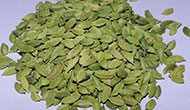
Scientific name :Elettaria cardamomum
Cardamom of commerce is the dried ripe fruit (capsules of cardamom plant) often referred as the “Queen of Spices” because of its very pleasant aroma and taste. Cardamom is a perennial, herbaceous, rhizomatous plant. Based on the nature of panicles, three varieties are recognized viz. Malabar with prostrate panicle, Mysore with erect panicle, and Vazhukka with semi erect panicle. Plants are of medium size (2 to 3 mtr height) with pubescent leaves (on the dorsal side) and fruits globose in the case of Malabar, whereas plant robust (3 to 4 mtr height) with leaves glabrous on both sides with ovoid capsules in the case of Mysore. Vazhukka variety is a mix of both the above in physical characteristics.
Indian cardamom is offered to the international markets in different grades: ‘Alleppey Green Extra Bold’ (AGEB), ‘Alleppey Green Bold’ (AGB) and ‘Alleppey Green Superior’ (AGS) are names that register instant appeal worldwide. Cardamom oil is a precious ingredient in food preparations, perfumery, health foods medicines and beverages. India, a traditional exporter of cardamom to the Middle East countries where it goes mostly into the preparation of ‘Gahwa’ – a strong cardamom – coffee concoction without which no day is complete or no hospitality hearty for an Arab. Indian cardamom enjoys a premium preference in the Middle East, Japanese and Russians who relish it for its distinct enriching properties.
Uses: The major use is for the preparation of ‘gahwa’ – a strong cardamom coffee concoction which is a symbol for hospitality among Arabs. Apart from this cardamom is widely used as a flavouring material in whole and ground form. In Asia, it can add a lingering sparkle to every kind of dishes both traditional and modern. In Scandinavian countries it is used in baked goods and confectionaries. In Europe and North America it is an ingredient in curry powder and in some sausages products. Cardamom oil and oleoresin has applications in flavouring processed foods, cordials, and liquors and in perfumery and in Ayurvedic medicines
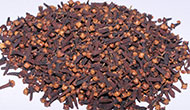
Scientific name : Syzygium aromaticum
The clove of commerce is the air-dried unopened flower bud obtained from evergreen medium sized tree. The tree grows to a height of 10-12 mtrs and start flowering in about 7 years. It continues to produce flower buds for 80 or more years. It is a valuable spice of the orient. Clove clusters are plucked by hand when the buds are fully developed with a pronounced pink flush and then dried over several days in the sun. Unopened flower buds, leaves and stalks yield essential oil.
Uses: The use of clove in whole or ground form is mainly for culinary purposes and as a flavouring agent in food industry. Its flavour blends well with both sweet and savory dishes. It is highly valued in medicine as carminative, aromatic and stimulant. In Indonesia, the lion share of production is consumed in production of ‘kretek’ cigarettes. The antiseptic and antibiotic properties of clove oil are used in medicine especially in dentistry, oral and pharyngeal treatments. It has wider applications in preparations of toothpaste and mouthwashes, soaps and perfumes. It is also reported to help diabetics in sugar assimilations.
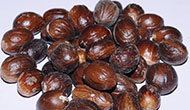
Scientific name : Myristica fragrans
Nutmeg & Mace are two distinctly different spices produced from a fruit of an evergreen tree usually 9-12 mtr high. Mace is the dried reticulated ‘aril’ of the fruit and nutmeg is the dried seed kernel of the fruit. The trees are normally unisexual, bearing either male or female flowers. The male flowers are born in clusters, whereas female flowers are often solitary. Fruit is a fleshy drupe, spherical in shape, pale yellow in colour with a longitudinal groove in the centre. When the fruit mature it burst open along the groove exposing the bright attractive mace, covering the hard black, shiny shell of the seed called nutmeg.
Uses: Both nutmeg and mace are used as condiment particularly in sweet foods. The spice in the ground form is mainly used in the food processing industry especially as a standard seasoning in many Dutch dishes. Nutmeg oleoresin is used in the preparation of meat products, soups, sauces, baked foods, confectionaries, puddings, seasoning of meat and vegetable etc. The fleshy outer cover of the fruit is crystallized or pickled or made into jellies. Mace is used in savoury dishes. It is used as a drug in Eastern countries because of its stimulant, carminative, astringent and aphrodisiac properties. Excessive doses have a narcotic effect. Nutmeg oil is used in cosmetics and toiletries.
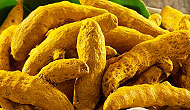
Scientific name : Curcuma longa
Turmeric is the boiled, dried, cleaned and polished rhizomes of Curcuma longa. The plant is a herbaceous perennial, 60-90 cm high, with a short stem and tufted leaf. There are 7 to 12 leaves, the leaf sheaths forms the pseudo stem. The lamina is green above and pale green below and has a length of 30-40 cm and width 8-12 cm. Inflorescence is a central spike of 10-15 cm length. 1-4 flowers are born in axil of the bract opening one at a time. About 30 flowers are produced in a spike. Seeds are produced in capsules and there will be one to numerous sunken capsules in an inflorescence.
Uses: Turmeric is used to flavour and to colour foodstuffs. It is a principal ingredient in curry powder. Turmeric oleoresin is used in brine pickles and to some extent in mayonnaise and relish formulations, non-alcoholic beverages, gelatins, butter and cheese etc. The colour curcumin extracted from turmeric is used as a colourant. Turmeric is also used as a dye in textile industry. It is used in the preparation of medicinal oils, ointments and poultice. It is stomachic, carminative, tonic, blood purifier and an antiseptic. It is used in cosmetics. The aqueous extracts has biopesticidal properties.
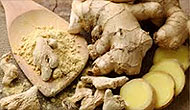
Scientific name: Zingiber officinale
Ginger of commerce is the dried underground stem of the herbaceous tropical plant grown as an annual. The whole plant is refreshingly aromatic and the underground rhizome, raw or processed, is valued as spice. Ginger is a slender perennial herb, 30-50 cm tall with palmately branched rhizome bearing leafy shoots. The leafy shoot is a pseudostem formed by leaf sheath and bears 8 to 12 distichous leaves
Uses: Fresh ginger, dry ginger powder, oleoresin and oil are used in food processing. It is indispensable in the manufacture of ginger bread, confectionary, ginger ale, curry powders, certain curried meats, table sauces, in pickling and in the manufacture of certain cordials, ginger cocktail, carbonate drinks, liquors etc. In medicine, it is used as carminative and stimulant. It has wider applications in indigenous medicines. The ginger oil is used as food flavourant in soft drinks
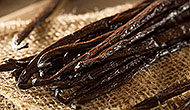
Scientific name: Vanilla planifolia
Vanilla, a member of the orchid family is a climbing monocot possessing a stout, succulent stem; short petioled, oblong leaves; about 20 cm long. The inflorescence is a raceme with 20 or more flowers. Flowers are 6 cm long, 2.5 cm wide, either yellowish green or white. Fruit popularly known as ‘beans’ or ‘pod’ is a capsule, nearly cylindrical and about 20 cm long.
Uses: Vanilla is used mainly as a flavouring material; a critical intermediary in a host of pharmaceutical products and as a subtle component of perfumes. As a flavouring agent, it is used in the preparation of ice creams, milk, beverages, candies, confectionaries and various bakery items.
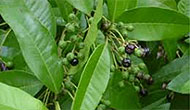
Scientific name: Pimenta dioica
Allspice trees are evergreen medium sized, grow up to a height of 8 to 10 meters and with a slender upright trunk and smooth greyish bark. The mail trees produce only few fruits. The male and female trees are similar in appearance and cannot be identified till flowering commences.
Uses: The major use of allspice is in food industry (65 to 70%) in domestic use (5% to 10%), production of berry oil (20% to 25%), extraction of oleoresin (1% to 2%) and pharmaceutical and perfume industry. Berry, berry oil, oleoresin, leaf oil are products of economic use. It is used mostly in Western cooking and less suitable for Eastern cooking. It has medicinal, anti-microbial, insecticidal, nematicidal, anti-oxidant and deodorant properties
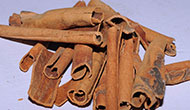
Scientific name: Cinnamomum verum
The “True Cinnamon” or Sri Lankan Cinnamon is the dried inner stem bark of Cinnamomum Verum. Cinnamon plants are grown as bushes. When the plants are of two years age, they typically measure at about 2 meter in high and 8-12 cm at the base. It is at this stage they are ready for harvesting.
Uses: The commercial products of cinnamon are quills, quillings, featherings, chips, cinnamon bark oil and cinnamon leaf oil. ‘Quills’ are scraped peel of the inner bark of the mature cinnamon shoots, joined together with overlapping tubes, the hollow of which has been filled with smaller pieces of cinnamon peels which is dried first in the sun and thereafter in the shade. ‘Quillings’ are broken pieces and splits of all grades of cinnamon quills. ‘Featherings’ are feather like pieces of inner bark consisting of shavings and small pieces of bark left over. Cinnamon ‘chips’ are rough unpeelable barks scraped off from the thicker stems. Cinnamon leaf and bark oil are obtained by distilling the leaf and bark separately. Cinnamon bark is a popular spice with a delicate fragrance and a warm agreeable taste. It is used in the form of small pieces or powder. It is widely used in flavouring confectionary, liquors, pharmaceuticals and cosmetics. It is found to help diabetics in digestion of sugar. It has astringent; stimulant and carminative properties and can check nausea and vomiting. The cinnamon bark oil has anti-fungal properties and cinnamon leaf oil is widely used in perfumery and cosmetics
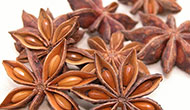
Scientific name: Illicium verum
Star anise is the dried, star shaped fruit of Illicium verum. It is an evergreen tree attaining a height of 8-15 meters and a diameter of 25 cm. The leaves are entire, 10-15 cm long, 2.5 – 5 cm broad, elliptic, flowers are solitary, white to red in colour. Fruits are star shaped, reddish brown consisting of 6-8 carpels arranged in a whorl. Each carpel is 10 mm long, boat shaped, hard and wrinkled containing a seed. Seeds are brown, compressed, ovoid, smooth, shiny and brittle.
Uses: Star anise is one of the signature flavours of Chinese savory cooking. The five-spice powder mix common in China contains star anise. It is used to flavour vegetables, meat, and to marinate meat. It is used as a condiment for flavouring curries, confectionaries, spirits, and for pickling. It is also used in perfumery. The essential oil of star anise is used to flavour soft drinks, bakery products and liquors. The fruit is anti-bacterial, carminative, diuretic and stomachic. It is considered useful in flatulence and spasmodic.
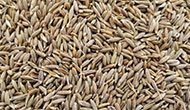
Scientific name: Cuminum cyminum
Cumin is the dried, white fruit with greyish brown colour of a small slender annual herb. The surface of the fruit has 5 primary ridges, alternatively has 4 less distinct secondary ridges bearing numerous short hairs. The plant is 15 to 50 cm high. The aromatic seed like fruit is elongated, ovoid, 3 to 6 mm long, slightly bitter and has a warm flavour. The flowers are white or rose coloured in small umbels.
Uses: Cumin seed have an aromatic odour and bitter taste. It is used as a condiment, and is an ingredient in curry powders, seasonings of breads, cakes and cheese. It is employed in native dishes of Central and South America. In medicine, it is used as a stimulant, carminative, stomachic and astringent. Cumin seed oil is used in perfumery and for flavouring liqueurs and cordial
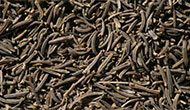
Scientific name: Nigella Sativa
Shahijeera is known in India as a royal cumin due to it robust cumin aroma and flavour. In the western world it is known as caraway seed. Caraway or Shahijeera of commerce is the fruit of a biennial herb known botanically as Carum carvi, Linn. It grows wild in India in the North Himalayan regions. The caraway seeds are brown in color, have a pleasant odor, aromatic flavor, warm and somewhat sharp taste (because of the presence of caravone). Seeds are hard and sharp in touch. Seeds can be used as whole or as in powder form. Caraway is widely used as a spice for culinary purposes and for flavoring bread, biscuits, cake. It is also used as an ingredient of sausage seasoning and pickling spice. It is mild stomachic and carminative, occasionally used in flatulence colic and as a adjuvant or currective for medicines.
Uses: Small Description: Aromatic, strong flavoring for Biriyani, breads. Exotic & flowery aroma, used as a seasoning & excellent for all digestive problems.
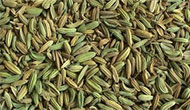
Scientific name: Foeniculum vulgare
It is a biennial, aromatic, stout, glabrous, 1.5 to 1.8 mtr high. The ripe fruit (seed) is small, oblong, cylindrical, 6.8mm long, straight or slightly curved, greenish yellow, deeply furrowed, 5 ridged and having agreeable aroma.
Uses: The leaves of fennel is used for garnishing. Leaves and stalks are used in salads. It is an essential ingredient in Italian sausages, widely used to sprinkle on pizza. Dried fruits have fragrant odour and pleasant aromatic taste and therefore used as a masticatory. They are also used for flavouring soups, meat dishes, sauces, pastries, confectionaries and liquors. The fruits are aromatic, stimulant and carminative.
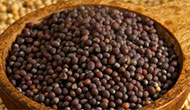
Scientific name: Brassica
Mustard is an annual herb cultivated as oil seed crop or as vegetable or as fodder, of which, 3 species are known for its condiment value. They are pale yellow or white mustard (Brassica hirta), brown mustard (Brassica juncea) and black mustard (Brassica nigra). The leaves of the plant are alternate, long, bristly branched, petiolate, hairy on both sides. Flowers are small, yellow with 4petals, cruciform. Seeds are 1.5-3mm.
Uses: The major processed products are mustard powder used in the manufacture of mayonnaise, dried or dehydrated mustard leaves, whole mustard seeds etc. Whole mustard is used as a flavouring agent in Indian cooking, whereas ground mustard provides flavour and consistency in Bengali fish curries. Mustard flour has preservative and antioxidant properties in addition to providing flavour and colour.
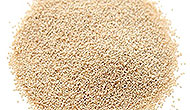
Scientific name: Papaver somniferum
Poppy seed is the dried seed of Papaver somniferum, an erect annual herb, 30-150 cm long with 0.5-1.5 cm thick stem. Stem is glabrous with thick waxy coating. Leaves are numerous, alternate, spreading horizontally, 15-25 cm long. Flowers are few, solitary, on a 10-15 cm long peduncle. Fruit is a capsule with waxy coating. Seeds are numerous, very small, white grey with an oily endosperm. Poppy is a self pollinated plant. The seed is the spice.
Uses: Poppy seed (Khas Khas) is used as food and as a source of fatty oil. It is widely used for culinary purposes. Because of its highly nutritive nature it is used in breads, cakes, cookies, pastries, curries, sweets and confectionery. Its seeds are demulcent and are used against constipation. The capsules are used as a sedative against irritant coughing and sleeplessness in the form of syrup or extract.
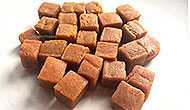
Scientific name: Ferula assa – foetida
Asafoetida is the dried latex (gum oleoresin) exuded from the living underground rhizome or tap root of several species of Ferula (three of which grow in India), which is a perennial herb (1 to 1.5 mtr. High).
Uses: Asafoetida is extensively used for flavouring curries, sauces, and pickles. It is also used in medicines because of its antibiotic properties.
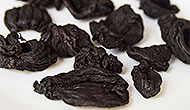
Scientific name: Garcinia indica
Kokum is a slender evergreen small tree with drooping branches. It is a dioecious tree growing up to 18 mtr high. The fruit is spherical, purple, not grooved having 5-8 seeds compressed in an acid pulp.
Uses: The ripened, rind and juice of Kokum fruit are commonly used in cooking. The dried and salted rind is used as a condiment in curries. It is also used as a garnish to give an acid flavour to curries and for preparing attractive, red, pleasant flavoured cooling syrup. Kokam butter used as an edible fat, is nutritive, demulcent and antiseptic. The rind has antioxidant property.
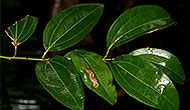
Scientific name: Cinnamomum tamala
Bay Leaf or Laurel Leaf are dried leaves or an evergreen shrub or more rarely a tree attaining a height of 15 to 20 mtrs. The upper surface of the leaf is glabrous and shiny, olive green, and lower surface is dull olive to brown with a prominent rib and veins. The aroma of the crushed leaves is delicate & fragrant and taste is aromatic and bitter. The size of the leaves is ranging from 2.5 to 7.5 cms in length and 1.6 to 2.5 cms in breadth. The shape is elliptical and tapering to a point at the base and tip of the leaves.
Uses: Bay leaves are used as flavouring in soups, stews, meat, fish, sauces and in confectionaries. Both leaves and fruits possess aromatic, stimulant and narcotic properties. The essential oil from the leaves are also used as spice and food flavouring agent and has wider application in traditional medicines of different countries. The major functional properties are anti-microbial, anti-fungal, hypoglycaemic, anti-ulcerogenic etc.
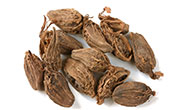
Scientific name: Amomum subulatum
Large Cardamom is a perennial herb with subterranean rhizomes and 50-140 aerial leafy shoots. Each shoot has height of 1.7 to 2.6 mtr and possess 9 to 13 leaves in each tiller. Leaves are glabrous on both sides with a prominent mid-rib. Inflorescence is a condensed spike with yellowish perianth. Each spike has 10-15 fruits. Fruit is round or oval shape, capsule with reddish brown colour. Each capsule is trilocular with many seeds.
Uses: It is used as a flavourant in dishes like Pulavu, Biriyani and meat preparations. It is an ingredient in curry powder and spice masala mixtures and is also used in Ayurvedic and Unani medicines. It has applications in flavouring cola, biscuits, liquors.
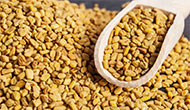
Scientific name: Trigonella foenum-graecum
Fenugreek seed is the ripe fruit of an annual herb. This robust herb has light green leaves, is 30-60 cm tall and produces slender, beaked pods, 10-15 cm long, each pod contains 10-20 small hard yellowish brown seeds, which are smooth and oblong, about 3mm long, each grooved across one corner, giving them a hooked appearance.
Uses: Fenugreek is used both as a food and food additive as well as in medicines. Fresh tender pods, leaves and shoots are eaten as curried vegetable. As a spice, it flavours food. Powder of dried leaves is also used for garnishing and flavouring variety of food. Fenugreek extract is used as a flavouring agent of imitation maple syrup. It is one of the principle constituent of curry powder. The seeds are used in colic flatulence, dysentery, diarrhoea, dyspepsia, chronic cough and enlargement of liver and spleen, rickets, gout and diabetes. It is also used as a carminative, tonic, and aphrodisiac. Fenugreek oil is used in the manufacture of hair tonics.
Other Products
Nutmeg Seed Powder
(Spices items)
Cardamom Seed Powder
(Spices items)
Allspice Seed Powder
(Spices items)
Cinnamon Powder
(Spices Items)
Vanilla Powder
(Spices items)
Small Gift Packs
(Spices items)
White pepper powder
(Spices items)
Ginger Powder
(Spices items)
Fruits
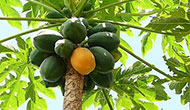
Scientific name: Carica papaya
The papaya (from Carib via Spanish), papaw or pawpaw is the fruit of the plant Carica papaya, in the genus Carica. It is native to the tropics of the Americas, and was first cultivated in Mexico several centuries before the emergence of the Mesoamerican classic cultures.It is a large tree-like plant, with a single stem growing from 5 to 10 metres (16 to 33 ft) tall, with spirally arranged leaves confined to the top of the trunk. The lower trunk is conspicuously scarred where leaves and fruit were borne. The leaves are large, 50–70 centimetres (20–28 in) diameter, deeply palmately lobed with 7 lobes. The tree is usually unbranched if unlopped. The flowers are similar in shape to the flowers of the Plumeria but are much smaller and wax-like. They appear on the axils of the leaves, maturing into the large 15–45 centimetres (5.9–18 in) long, 10–30 centimetres (3.9–12 in) diameter fruit.
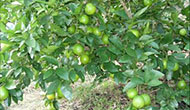
Scientific name: Citrus limetta
It is a small tree which may reach 8 m in height. The sweet lemon has irregular branches, and relatively smooth, brownish-grey bark. It possesses numerous thorns which may grow to anywhere from 1.5 to 7.5 cm long. The petioles of the sweet lemon are narrowly but distinctly winged, and are 8 to 29 mm long. It has leaflets rather than leaves, which are obovate and 5.5 to 17 cm long, 2.8 to 8 cm wide. The apex of the leaflet is acuminate, and the base of the leaflet is rounded. Flowers are white in bud and in bloom, ranging from 2 to 3 cm wide. The petals soon fall away, leaving the fruit to grow. The skin of the fruit is light yellow at maturity; the rind is white and about 5 mm thick. The pulp is greenish and the juice is sweet rather than acidic.
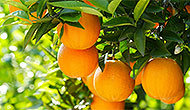
Scientific name: Citrus reticulata
The orange is a hybrid of ancient cultivated origin, possibly between pomelo (Citrus maxima) and mandarin (Citrus reticulata). It is a small flowering tree growing to about 10 m tall with evergreen leaves, which are arranged alternately, of ovate shape with crenulate margins and 4–10 cm long. The orange fruit is a hesperidium, a type of berry.Fruits of all members of the genus Citrus are considered berries because they have many seeds, are fleshy, soft, and derive from a single ovary. An orange seed is called a pip. The white thread-like material attached to the inside of the peel is called pith.
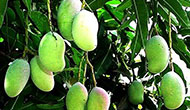
Scientific name : Mangifera indica
The mango is indigenous to the Indian subcontinent. Cultivated in many tropical and subtropical regions and distributed widely in the world, mango is one of the most extensively exploited fruits for food, juice, flavor, fragrance and color.Mango trees (Mangifera indica L.) grow 35–40 m (115–130 ft) tall, with a crown radius of 10 m (33 ft). The mango tree is long-lived; some specimens still fruit after 300 years. In deep soil the taproot descends to a depth of 6 m (20 ft) and the profuse, wide-spreading feeder roots also send down many anchor roots which penetrate several feet of soil. The leaves are evergreen, alternate, simple, 15–35 cm (5.9–14 in) long and 6–16 cm (2.4–6.3 in) broad; when the leaves are young they are orange-pink, rapidly changing to a dark glossy red, then dark green as they mature.
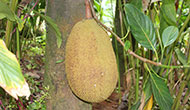
Scientific name : Artocarpus heterophyllus
It is well suited to tropical lowlands. Its fruit is the largest tree borne fruit in the world, Reaching 80 pounds (36 kg) in weight and up to 36 inches (90 cm) long and 20 inches (50 cm) in diameter.The flesh of the jackfruit is starchy, fibrous and is a source of dietary fiber. Varieties of jackfruit are distinguished according to the characteristics of the fruits’ flesh. In Brazil, three varieties are recognized. The wood of the tree is used for the production of musical instruments. In Indonesia it forms part of the gamelan and in the Philippines, its soft wood is made into the hull of a kutiyapi, a type of Philippine boat lute. It is also used to make the body of the Indian drums mridangam and kanjira, the Golden yellow colured timber with good grains is used for building furniture and house construction in India.
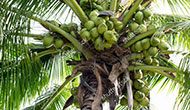
Scientific name: Cocos nucifera
Coconut trees are very hard to establish in dry climates, and cannot grow there without frequent irrigation; in drought conditions, the new leaves do not open well, and older leaves may become desiccated; fruit also tends to be shed. Botanically the coconut fruit is a drupe, not a true nut. Like other fruits it has three layers: exocarp, mesocarp, and endocarp. The exocarp and mesocarp together make up the husk, and the mesocarp is composed of fibers called coir. Coconuts sold in the shops of non-tropical countries often have had the husk removed. The endocarp or shell is the hardest part of the coconut. The shell has three germination pores (stoma) or eyes that are clearly visible on its outside surface once the husk is removed.
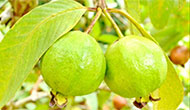
Scientific name: Psidium guajava
Psidium guajava, is an evergreen shrub or small tree in the family Myrtaceae grown for its edible fruits. Guava has a slender trunk with smooth green to red-brown bark. … The fruit is oval in shape and green to yellow in color.
Uses: The fruit is commonly eaten fresh or made into beverages, jams, and other foods. The fruit, leaves, and juice are also used as medicine. People use guava for colic,diarrhea, diabetes, cough, cataracts, high cholesterol, heart disease, and cancer
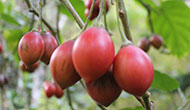
Scientific name: Solanum betaceum
Juicy, sweet and citric, tamarillo or tree tomato is a small oval-shaped fruit. It is closely related to other Solanaceae family of vegetables and fruits such as tomato, eggplant, tomatillo, groundcherry, and chili peppers. Tree tomatoes are thought to have originated in the semitropical high altitude Andes forests of Brazil and Peru. The fruits cultivated at a commercial scale in large orchards in northern parts of New Zealand and exported to USA, Australia, Japan and European Union countries.
Uses: The fruits are very high in vitamins and iron and low in calories (only about 40 calories per fruit).
Water Apple/Bell Fruit Preserve
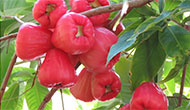
Scientific name: Syzygium Samarangense
Also known as a wax apple or bell apple. Tropical fruit shaped similar to a small bell or small pear with red coloured skin. Flesh has a crunchy texture, is sweet and very juicy, the juice is actually purple.
Uses: The fruits are egg shaped and about 4-10 centimeters long. Their color varies from yellow and orange to red and almost purple. Sometimes they have dark, longitudinal stripes. Red fruits are more acetous, yellow and orange fruits are sweeter. The flesh has a firm texture and contains more and larger seeds than a common tomato.
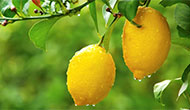
Scientific name: Citrus limon
Lemon, Citrus limon, is a small evergreen tree in the family Rutaceae grown for its edible fruit which, among other things, are used in a variety of foods and drinks. The tree has a spreading, upright growth habit, few large branches and stiff thorns.
Uses: Lemon juice, rind, and zest are used in a wide variety of foods and drinks. Lemon juice is used to make lemonade, soft drinks, and cocktails. It is used in marinades for fish, where its acid neutralizes amines in fish by converting them into nonvolatile ammonium salts, and meat, where the acid partially hydrolyzes tough collagen fibers, tenderizing the meat, but the low pH denatures the proteins, causing them to dry out when cooked. The leaves of the lemon tree are used to make a tea and for preparing cooked meats and seafoods.
Garlic
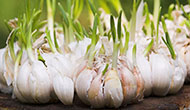
Scientific name: Allium sativum
Allium sativum is a bulbous plant. It grows up to 1.2 m (4 ft) in height. Its hardiness is USDA Zone 8. It produces hermaphrodite flowers. It is pollinated by bees and other insects.
Uses: Garlic is widely used around the world for its pungent flavor as a seasoning or condiment.The garlic plant’s bulb is the most commonly used part of the plant. With the exception of the single clove types, garlic bulbs are normally divided into numerous fleshy sections called cloves. Garlic cloves are used for consumption (raw or cooked) or for medicinal purposes. They have a characteristic pungent, spicy flavor that mellows and sweetens considerably with cooking.